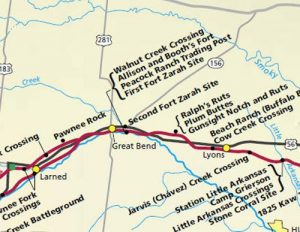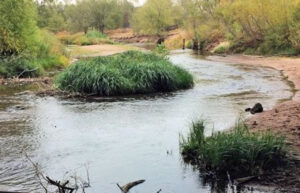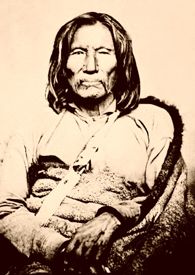The first Fort Atkinson was established in 1850 in Ford County, Kansas, about two miles west of present-day Dodge City. However, the post was moved to Walnut Creek in Barton County in 1853.
Walnut Creek Crossing had long been a Santa Fe Trail stop along the Arkansas River about two miles east of Great Bend. When the creek flooded, wagon trains would camp on its banks for days waiting to cross. A post office called Walnut Creek was established on August 22, 1853.
William Allison and Francis Boothe established a trading post in a large log building in the summer of 1855, selling supplies and provisions to travelers. The Walnut Creek Ranch was the first non-military building erected west of Council Grove. The site also included a toll bridge over the river, one of the region’s first toll bridges.
The same year, the troops from Fort Atkinson were moved from Ford County to Walnut Creek, and the post office’s name was changed to Fort Atkinson on August 4, 1855. The military post was a simple camp comprised of several dugouts built of adobe and logs with mud roofs.
“Walnut Creek Station. Allison & Booth. Respectfully informs their friends and the general public that they have established a trading house and general depot at Walnut Creek on Santa Fe road, where they constantly keep on hand groceries and provisions suitable for travelers. Also, for Forage. With corrals and enclosures for the security of animals, prices are reasonable.”
— Santa Fe Gazette, February 1857
By the summer of 1857, the troops had moved out, and the post office closed on June 5, 1857. In September 1857, trading post owner Francis Boothe was murdered by a Mexican.
“The Mexican who brutally murdered Mr. Booth at Walnut Creek last month by splitting his head open with an ax was arrested in San Miguel County last week.”
— Santa Fe Gazette, October 31, 1857
In mid-October 1858, the “Larimer Party,” en route to the South Platte River in Colorado, stopped at Walnut Creek Ranch. William Henry. Larimer, in reminiscences, wrote:
“Mr. Allison, in his buckskin suit, was a fine specimen of frontiersman. He kept a fine stock of Indian goods and had a good trade with the Indians. All around the ranch, buffalo by the hundreds, undisturbed, were grazing like cattle. Mr. Allison tried to leave the impression on our minds that the Indians were not, just now, on the best terms with the whites… He might have done this only to intimidate us, but we took it as good advice and exercised great caution.” From Walnut Creek to beyond Pawnee Fork, according to Larimer, “the country was black with buffalo.”
In 1859, the Santa Fe Trail was a busy thoroughfare. The Council Grove, Kansas, Press of April 30 stated that over 150 Pike’s Peak-bound wagons had passed through on the 28th; trains of 10 to 40 wagons were “constantly arriving” from New Mexico; and the “outbound” freighting season was underway. According to trader Seth Hays’ records, between April and mid-June, 1,400 wagons carrying 3,562 tons of freight passed through Council Grove for the west. These figures did not include the Pike’s Peak emigrants’ wagons or the incidental trade of the road. (Up to September 8, the season’s total was recorded as 2,170 wagons and 8,000 tons of freight.) All this traffic also passed Walnut Creek Ranch.
On September 23, 1859, while the cavalry troops were camped at Walnut Creek Crossing, a Santa Fe-bound mail stage arrived. Three employees — Michael Smith, his brother Lawrence, and William Cole — were aboard. Captain DeSaussure assigned Lieutenant Elmer Otis and a 25-man detail to escort the mail carriers to Pawnee Fork. Early on the 24th, they set out. Subsequently, about four miles beyond Pawnee Fork, 15 or 16 Kiowa Indians waylaid the stagecoach, killed the Smith brothers, and severely wounded William Cole. The following day, only a few miles from that point, the same party of Indians murdered four returning “Pike’s Peakers.” Other Kiowa aggressions followed — mainly in the area between Coon Creek and Cimarron Crossing and farther up the Arkansas River. On November 1, a Denver-bound man wrote: “The Indians have positively killed nine whites in all, and maybe 13, on this road.”
The dangers of Santa Fe trail travel in the fall were not underestimated by William Bent, who was “taking out a large quantity of Indian goods and hardware” to his trading fort in Colorado. On November 4, eastbound travelers met “Bent’s train with two pieces of artillery at Big Bend.”
In April 1859, William Allison traveled to Missouri and, while there, died of heart failure. George Peacock of Independence, Missouri, next operated the trading post. Formerly in the Santa Fe trade and later in charge of the Ives Expedition’s mule train, Peacock was an experienced plainsman and adventurer in the West. He was killed in September 1860 by Kiowa Chief Satank.
“Mr. Peacock, of Peacock’s Ranch, better known by the old name of Allison’s Ranch, arrived here yesterday with several wagons loaded with furs. Among the rest were 2,000 wolf skins. They were sold to Messrs. W.T. Wheatley & Co. This firm alone has bought over 5,000 wolf pelts this spring, besides a large amount of other furs. Several other firms have, probably, received as many.”
— Kansas City Journal of Commerce, April 7, 1860
George Peacock was killed in September 1860 by Kiowa Chief Satank.
Shortly after Peacock’s death, the post was taken over by Charles Rath, a well-known buffalo hunter who operated it until 1867.
In April and May 1861, the Council Grove Press editor described Santa Fe trail traffic, both east and west, as extensive and reported all quiet on the Arkansas route. However, a little-publicized massacre occurred in late April near Walnut Creek. A Fort Larned correspondent reported that Kiowas had killed and scalped six Mexicans (from a small wagon train) who were hunting buffalo off the road. So far as known, this was the Plains Indians’ only depredation of consequence along the route in 1861.
Charles Rath, John F. Dodds, James A. Robbins, F. Lederick, and A.D. Robbins, in January 1863, formed the Walnut Creek Bridge Company “to build a toll bridge over Walnut Creek. It was probably completed in time to collect tolls from the spring-season traffic.
After Rath left the ranch, it was taken over by a man named Joseph W. Douglas until the store was burned down by Arapaho and Cheyenne Indians on May 19, 1868.
The site of Walnut Creek Crossing is about two miles east of Great Bend and south of US Highway 56. The trading post was about 100 yards from the crossing of Walnut Creek, on the east side of the creek and north of the Santa Fe Trail.
©Kathy Alexander/Legends of Kansas, updated August 2025.
Also See:
Sources:
Kansas Historical Society
National Park Service
Santa Fe Trail Historic Sites



